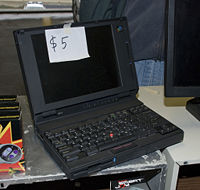ThinkPad: Difference between revisions
imported>Chunbum Park |
imported>Chunbum Park |
||
| Line 3: | Line 3: | ||
== History == | == History == | ||
{{Image|IBM Portable Personal Computer.jpg|right|250px|The IBM 5155 portable computer.}} | {{Image|IBM Portable Personal Computer.jpg|right|250px|The IBM 5155 portable computer. }} | ||
The ThinkPad's beginning can be traced back to the 1980s when mobile computing was emerging as a new segment of the PC industry. The earliest form of mobile computing was the [[portable computer]], which incorporated the keyboard and display into the main body in a more conveniently "transportable" package. In response to the success of the [[Compaq Portable]] that was released in November 1982,<ref name="britannicacompaq">"'''computer'''." [http://www.britannica.com/EBchecked/topic-art/130429/19722/The-Compaq-portable-computer-Compaq-Computer-Corporation-introduced-the-first Encyclopædia Britannica]. 2009. Encyclopædia Britannica Online. 12 Sep. 2009 <[http://www.britannica.com/EBchecked/topic/130429/computer http://www.britannica.com/EBchecked/topic/130429/computer]></ref> IBM introduced the Portable Personal Computer ([[IBM Portable Personal Computer|5155 model 68]]) in February 1984. Although IBM's entry into the portable market was highly anticipated and was preceded by declines in stocks prices of competitors like [[Compaq]], the 5155 turned out to be a mediocre product that merely reinforced the market dominance of the Compaq Portables.<ref name="nytimeswallstreetportable">SANDBERG-DIMENT, ERIK. "Advertise on NYTimes.com PERSONAL COMPUTERS; RIVALS STAY ONE STEP AHEAD OF I.B.M. PORTABLE." ''The New York Times'' 13 Mar. 1984. ''www.nytimes.com''. Web. 12 Sept. 2009. <[http://www.nytimes.com/1984/03/13/science/personal-computers-rivals-stay-one-step-ahead-of-ibm-portable.html?&pagewanted=all http://www.nytimes.com/1984/03/13/science/personal-computers-rivals-stay-one-step-ahead-of-ibm-portable.html?&pagewanted=all]>.</ref><ref name="blueshade19-39">Deborah and Purdy. pp. 19-39.</ref> | |||
{{Image|IBM ThinkPad 700C.jpg|right|200px|The ThinkPad 700C.}} | {{Image|IBM ThinkPad 700C.jpg|right|200px|The ThinkPad 700C.}} | ||
Revision as of 02:59, 12 September 2009
ThinkPad is a professional-oriented brand of laptop and tablet PCs manufactured by Lenovo, which secured the rights to the ThinkPads through its acquisition of the IBM's PC division in 2005. The ThinkPad was first conceived as a dedicated tablet lacking a keyboard, but it emerged as primarily a notebook brand with the successful debut of the models 700 and 700C in October 1992. The 700/C and the subsequent ThinkPad models took the shape of a black rectangular case, featuring a red rubber cap at its keyboard's center as a pointing device.
History
The ThinkPad's beginning can be traced back to the 1980s when mobile computing was emerging as a new segment of the PC industry. The earliest form of mobile computing was the portable computer, which incorporated the keyboard and display into the main body in a more conveniently "transportable" package. In response to the success of the Compaq Portable that was released in November 1982,[1] IBM introduced the Portable Personal Computer (5155 model 68) in February 1984. Although IBM's entry into the portable market was highly anticipated and was preceded by declines in stocks prices of competitors like Compaq, the 5155 turned out to be a mediocre product that merely reinforced the market dominance of the Compaq Portables.[2][3]
I wanted to create a volume as simple as possible and as expressive as possible... and I thought the form of a cigar box, which at that time corresponded to the dimensions... more or less than a laptop computer had to have, would be an expression of what I wanted to do. I wanted to make an object that looks like a black cigar box and that shows on the outside nothing of being what it is... except for the logo of the producer. Then, when you open it, you see this is not a cigar box, but it is a computer, and you see all the complicated stuff inside. And that would create a surprise, and this is the basic concept of the ThinkPad.
- Richard Sapper
notes
- ↑ "computer." Encyclopædia Britannica. 2009. Encyclopædia Britannica Online. 12 Sep. 2009 <http://www.britannica.com/EBchecked/topic/130429/computer>
- ↑ SANDBERG-DIMENT, ERIK. "Advertise on NYTimes.com PERSONAL COMPUTERS; RIVALS STAY ONE STEP AHEAD OF I.B.M. PORTABLE." The New York Times 13 Mar. 1984. www.nytimes.com. Web. 12 Sept. 2009. <http://www.nytimes.com/1984/03/13/science/personal-computers-rivals-stay-one-step-ahead-of-ibm-portable.html?&pagewanted=all>.
- ↑ Deborah and Purdy. pp. 19-39.


